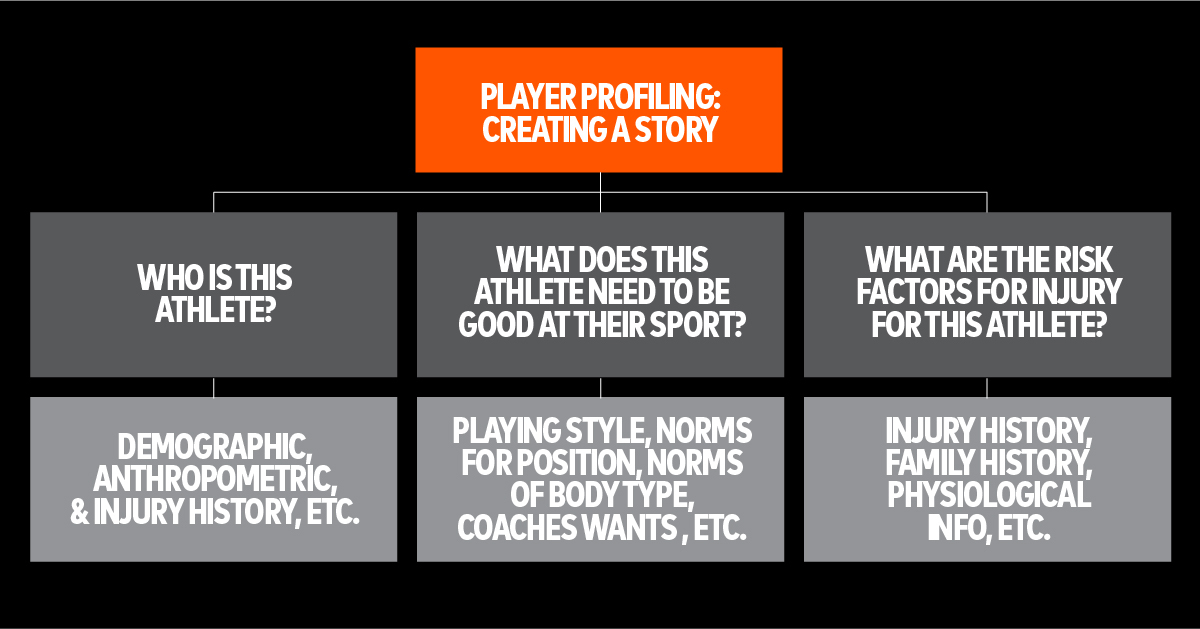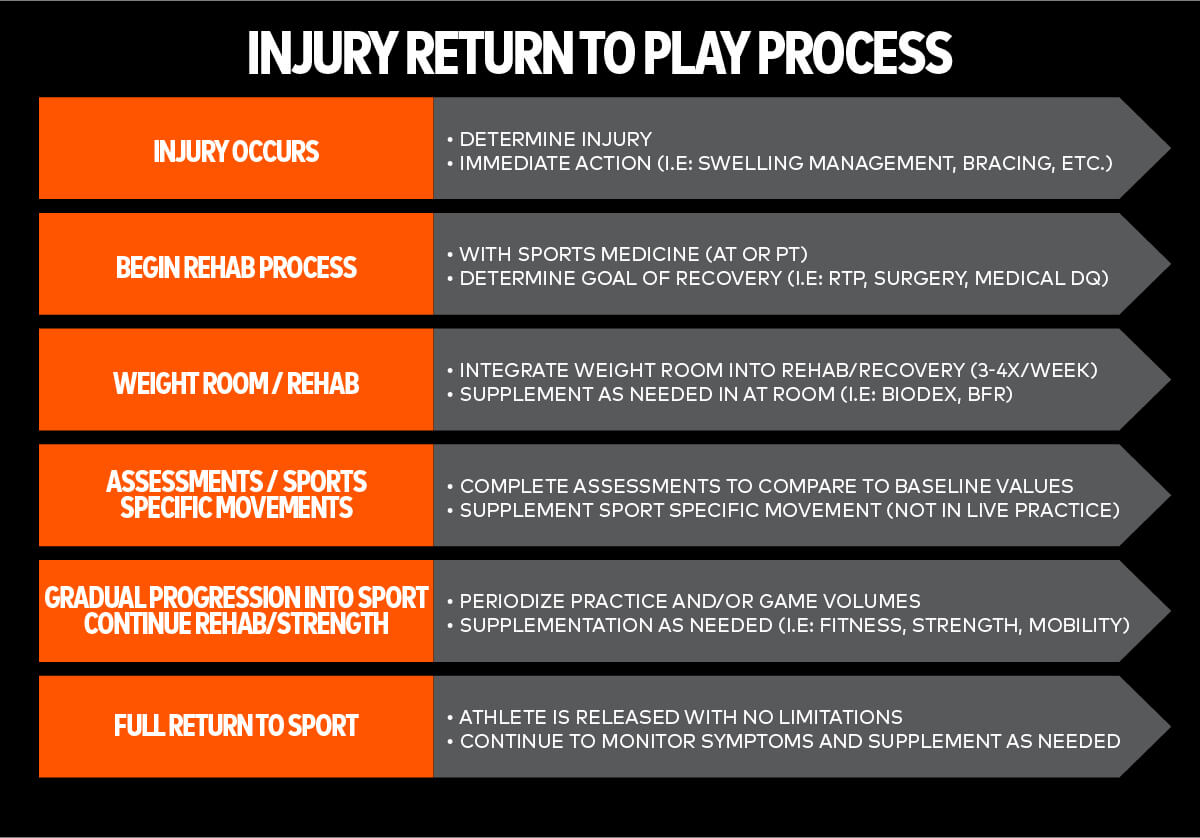Expert Strategies for Player Profiling and Safe Return to Play in Field Sports
Our recent webinar features the University of Notre Dame’s Associate Director of Strength and Conditioning, Michelle Truncali. In the webinar, she shares how her teams use data to profile players and effectively return them to play following injuries.
Truncali also breaks down her player management philosophy and her two main goals of decreasing the risk of injury and improving the performance of our student-athletes. After watching the webinar you will be able to answer the questions:
- What is player profiling and why it is so important?
- How to profile student-athletes within the context of an injured athlete?
- What stages do I need to take to ensure a safe, yet, quick return to play?
→ Click here to watch this player profiling and return to play webinar.
Optimizing performance with Player Profiling
Player profiling is a crucial aspect of sports training and performance analysis. By understanding the strengths and weaknesses of individual athletes, coaches and trainers can develop targeted training programs and strategies to optimize performance.
There are a variety of different methods and tools that can be used for player profiling in sport, including physiological testing, biomechanical analysis, and psychological assessments. Each of these methods provides unique insights into the athlete’s capabilities and limitations, and can be used in combination to create a comprehensive profile of the athlete.
Physiological Testing
Physiological testing involves measuring various physiological parameters, such as VO2 max, lactate threshold, and muscle power, to assess an athlete’s fitness and physical capabilities. This type of testing can provide information on the athlete’s cardiovascular and muscular fitness, as well as their energy systems and muscle fiber type.
Biomechanical Analysis
Biomechanical analysis involves the use of motion capture technology and other tools to study the mechanics of an athlete’s movement. This can include analyzing running and jumping mechanics, as well as the technique used in specific sports skills. Biomechanical analysis can help identify areas for improvement in technique and movement efficiency, as well as identifying any muscle imbalances or joint restrictions that may be impacting performance.
Psychological Assessments
Psychological assessments are used to evaluate an athlete’s cognitive abilities, personality traits, and emotional responses. This type of testing can include intelligence tests, memory tests, and personality tests. The results of psychological assessments can provide insight into an athlete’s mental strengths and weaknesses, as well as how they may respond to different types of stressors and pressure.
Combining Methods for a Comprehensive Profile
Each of these methods provides valuable information, but a comprehensive profile of an athlete should include insights from all three areas. By combining physiological testing, biomechanical analysis, and psychological assessments, coaches and trainers can gain a comprehensive understanding of the athlete’s capabilities and limitations.
Practical Applications
There are a variety of practical applications for player profiling in sports. Coaches can use this information to develop targeted training programs that focus on areas for improvement and optimize performance. Athletic trainers can use the information to identify and prevent injuries. Sports scientists can use this information to inform the development of new training methods and technologies.

Summary – Player Profiling
Player profiling in sports is a valuable tool for understanding athletes and optimizing performance. By using a combination of physiological testing, biomechanical analysis, and psychological assessments, coaches and trainers can gain a comprehensive understanding of the athlete’s capabilities and limitations. This information can be used to develop targeted training programs and strategies to improve performance and reduce the risk of injury.
Why is an effective return to play so important?
One of the key functions of athlete monitoring technologies is helping NCAA programs to use performance data to reduce injury risk among their athletes. As many sports become increasingly physically demanding, it can be challenging to maintain high rates of athlete availability.

Our latest report (centred on American Football programs), outlined that injuries cost NCAA programs up to an estimated $1.5 billion per year (Fair., et al 2018), with athletes getting 8.1 injuries per 1000 contact exposures (López-Valenciano., et al 2019), some of the highest figures in American Sports.
Across the pond, and according to the insurance broker JLT Specialty, Premier League clubs paid a total of £217m to injured players during the 2017/18 season, with a similar figure being reported for the NBA. With the financial stakes apparently so high, the ability to establish a robust return to training processes has never been more important.
Effective rehabilitation protocols are a subtle blend of art and science, drawing on the expertise and intuition of medical staff. This expertise can then be combined with objective information regarding player workloads and responses to training stimuli.
By monitoring athletes with our technology, coaches can reach an enhanced, objective understanding of the physiology of their athletes. It is possible to identify the ‘red flags’ that are associated with injury.
How to Return to Sport After Injury
Injuries are an unfortunate reality for athletes and sports enthusiasts. Whether it’s a sprained ankle, a pulled muscle, or a more serious injury, the road to recovery can be long and challenging. But with the right approach and support, it is possible to return your athletes to the sports they love and perform at their best.
In Truncali’s webinar, she specifically shares everything you need to know to return to sport after an injury, including:
- The importance of longitudinal and daily player profiling
- How to decrease the risk of injury through data
- Creating benchmarks for players with data, and when to re-test
- How to effectively communicate the data with coaches and staff
- If ACL reconstruction surgery is always the answer
The first step in returning to sport after an injury is to properly diagnose and treat the injury. This should always be done under the guidance of a medical professional, such as a sports doctor or physical therapist. They will be able to assess the extent of your injury and develop a treatment plan that is tailored to your specific needs.
The next step in the process of returning to sport after an injury is rehabilitation and physical therapy. These are crucial for not only recovering from the injury itself, but also for rebuilding strength, flexibility, and overall fitness. A physical therapist will be able to design an exercise program that is tailored to your individual needs, which may include exercises to increase range of motion, strengthen muscles, and improve balance and coordination.
It is also important to not rush the recovery process, as this increases the risk of re-injury. A gradual, step-by-step approach is recommended, with an increasing level of intensity and difficulty as the injury improves. As a general rule of thumb, it’s best to avoid any activity that causes pain or discomfort.
While you are recovering, it is also important to have a plan in place to ensure that you are able to return to your sport safely, and with a reduced risk of re-injury. This may involve gradually reintroducing sport-specific movements and exercises, as well as working on any underlying issues that may have contributed to the original injury.
Another important aspect of injury recovery is coping with mental and emotional challenges. Recovering from an injury can be a stressful and frustrating process, and it’s important to have a support system in place. This may include family and friends, as well as a mental health professional or counselor, who can provide guidance and support throughout the process.
In addition, setting achievable goals, learning relaxation techniques and visualisation, and staying positive can help to boost your motivation and help you stay focused on your recovery.
In summary, returning to sport after an injury requires a comprehensive approach that involves proper diagnosis and treatment, rehabilitation and physical therapy, a gradual and safe return to sport, and strategies for coping with the mental and emotional challenges of recovery. With the right approach and support, it is possible to return to the sports you love and perform at your best.